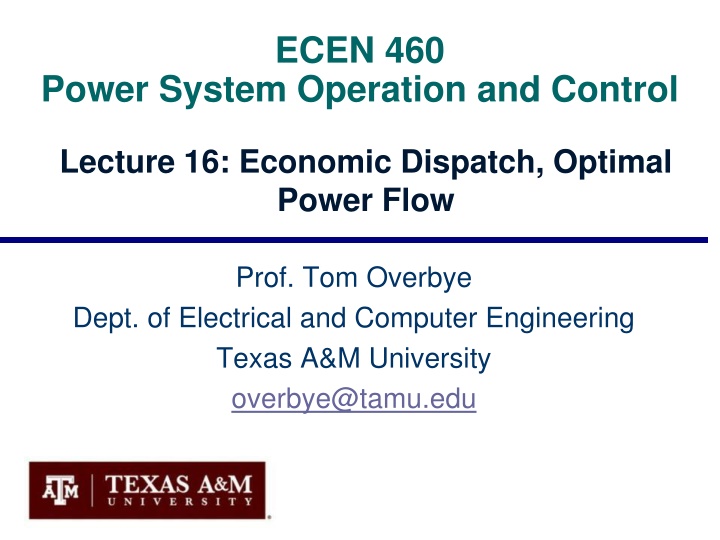
Economic Dispatch and Optimal Power Flow in Power Systems
Learn about economic dispatch and optimal power flow in power systems, including generator MW limits, lambda-iteration method, examples with generation limits, and back-of-envelope values for estimating incremental costs. Discover how power generation is optimized to meet demand efficiently while considering cost factors and operational constraints.
Download Presentation

Please find below an Image/Link to download the presentation.
The content on the website is provided AS IS for your information and personal use only. It may not be sold, licensed, or shared on other websites without obtaining consent from the author. If you encounter any issues during the download, it is possible that the publisher has removed the file from their server.
You are allowed to download the files provided on this website for personal or commercial use, subject to the condition that they are used lawfully. All files are the property of their respective owners.
The content on the website is provided AS IS for your information and personal use only. It may not be sold, licensed, or shared on other websites without obtaining consent from the author.
E N D
Presentation Transcript
ECEN 460 Power System Operation and Control Lecture 16: Economic Dispatch, Optimal Power Flow Prof. Tom Overbye Dept. of Electrical and Computer Engineering Texas A&M University overbye@tamu.edu
Announcements Finish reading Chapter 6 Homework 6 is 6.58, 6.59, 6.60, 6.62, 6.63; it is due on Tuesday Oct 31 1
Generator MW Limits Generators have limits on the minimum and maximum amount of power they can produce Often times the minimum limit is not zero. This represents a limit on the generator s operation with the desired fuel type Because of varying system economics usually many generators in a system are operated at their maximum MW limits. 2
Lambda-Iteration with Gen Limits In the lambda-iteration method the limits are taken into account when calculating P ( ): if P ( ) then P ( ) Gi P P = = Gi P Gi ,max Gi ,max Gi if P ( ) then P ( ) P Gi ,min Gi ,min Gi Gi 3
Lambda-Iteration Gen Limit Example In the previous three generator example assume the same cost characteristics but also with limits 0 P 300 MW 200 P 600 MW With limits we get 100 P 500 MW G1 G2 G3 m (20) 1000 = + + (20) 100 (20) (20) 0 P P P P 1 2 3 Gi G G G = 1 i = 250 100 + + 450 MW (compared to -670MW) = 200 m (30) 1000 = 300 500 + + 480 1000 = 280 MW P Gi = 1 i 4
Lambda-Iteration Limit Example,contd Again we continue iterating until the convergence condition is satisfied. With limits the final solution of , is 24.43 $/MWh (compared to 23.53 $/MWh without limits). The presence of limits will alwa cause to either increase or remain the same. Final solution is P (24.43) 300 MW P (24.43) 443 MW P (24.43) 257 MW = ys = = G1 G2 G3 5
Back of Envelope Values Often times incremental costs can be approximated by a constant value: $/MWhr = fuelcost * heatrate + variable O&M Typical heatrate for a coal plant is 10, modern combustion turbine is 10, combined cycle plant is 7 to 8, older combustion turbine 15. Fuel costs ($/MBtu) are quite variable, with current values around 1.5 for coal, 4 for natural gas, 0.5 for nuclear, probably 10 for fuel oil. Hydro, solar and wind costs tend to be quite low, but for this sources the fuel is free but limited 6
Inclusion of Transmission Losses The losses on the transmission system are a function of the generation dispatch. In general, using generators closer to the load results in lower losses This impact on losses should be included when doing the economic dispatch Losses can be included by slightly rewriting the Lagrangian: m C P = m = + + P L( , ) ( ) ( ( ) ) P P P P G i Gi D L G Gi = 1 1 i i 7
Impact of Transmission Losses This small change then impacts the necessary conditions for an optimal economic dispatch m m , ) = + + P L( ( ) ( ( ) ) C P P P P P G i Gi D L G Gi = = 1 1 i i The necessary conditions for a minimum are now L( , ) ( i dC P P d Gi m P P P P = P ) ( ) P P P G Gi L G = = (1 ) 0 P Gi Gi + = ( ) 0 D L G Gi 1 i 8
Impact of Transmission Losses Solving each equation for we get ( ) (1 Gi dP ( ) dC P P P P i Gi L G = 0 Gi dC P dP ( ) 1 i Gi = ( ) P P P Gi L G 1 Gi th Define the penalty factor L for the i generator 1 L ( ) 1 Gi P i The penalty factor at the slack bus is always unity! = i P P L G 9
Impact of Transmission Losses The condition for optimal dispatch with losses is then ( ) ( 1 Since L ( ) 1 Gi P P P P i appear to be more expensive (i.e., it is penalized). Likewise L appear less expensive. = = = ) ( ) L IC P L IC P L IC Gm P 1 1 1 2 2 2 G G m m = if increasing P increases i Gi P P L G ( ) L G the losses then 0 1.0 L i Gi This makes generator 1.0 makes a generator i 10
Calculation of Penalty Factors Unfortunately, the analytic calculation of L is somewhat involved. The problem is a small change in the generation at P impacts the flows and hence the losses throughout the entire system. However, using a power flow you can approximate this function by making a small change to P and then seeing how the losses change: ( ) ( ) L G L G P P P P P P i Gi Gi 1 P P P L i ( ) L G 1 Gi Gi Gi 11
Two Bus Penalty Factor Example P P ( ) ( ) 0.37 10 P P P L MW MW L P = G L G 0.0387 = = = 0.037 2 0.9627 G Gi 0.9643 L 2 2 12
Example 6.22 58 MW 56 MW 39 MW 39 MW 78 MW 29 Mvar A A 39% MVA 21% MVA 1.05 pu 0.99 pu 3 4 1 1.00 pu 130.0 MW 72 MW 52 MW 147 MW 39 Mvar 46 MW 0.0000 AGC ON 92.5 MW slack -0.0825 AGC ON A A 53% MVA 46% MVA A A 38% MVA 48% MVA 54 MW 20 MW 71 MW A 47 MW 60% MVA 1.04 pu 0.96 pu 112 MW 107 MW 5 2 181.9 MW 39 MW 20 Mvar 127 MW 39 Mvar -0.0274 AGC ON Load Scalar: 1.00 Total Hourly Cost: 5916.04 $/h MW Losses: 12.44 MW Total Area Load: Marginal Cost ($/MWh): 392.0 MW 0.00 $/MWh 13
Lab Seven Introduction: 37 Bus Lab seven covers economic dispatch and contingency analysis for the two systems from lab six 14
Optimal Power Flow (OPF) OPF functionally combines the power flow with economic dispatch Minimize cost function, such as operating cost, taking into account realistic equality and inequality constraints Equality constraints bus real and reactive power balance generator voltage setpoints area MW interchange 16
OPF, contd Inequality constraints transmission line/transformer/interface flow limits generator MW limits generator reactive power capability curves bus voltage magnitudes (not yet implemented in Simulator OPF) Available Controls generator MW outputs transformer taps and phase angles 17
Two Example OPF Solution Methods Non-linear approach using Newton s method handles marginal losses well, but is relatively slow and has problems determining binding constraints Linear Programming fast and efficient in determining binding constraints, but can have difficulty with marginal losses. used in PowerWorld Simulator 18
LP OPF Solution Method Solution iterates between solving a full ac power flow solution enforces real/reactive power balance at each bus enforces generator reactive limits system controls are assumed fixed takes into account non-linearities solving a primal LP changes system controls to enforce linearized constraints while minimizing cost 19
Two Bus with Unconstrained Line With no overloads the OPF matches the economic dispatch Transmission line is not overloaded Total Hourly Cost : Area Lambda : 13.01 8459 $/hr Bus B Bus A 13.01 $/MWh 13.01 $/MWh 300.0 MW MW 300.0 MW MW 197.0 MW AGC ON MW 403.0 MW AGC ON MW Marginal cost of supplying power to each bus (locational marginal costs) 20
Two Bus with Constrained Line Total Hourly Cost : Area Lambda : 13.26 9513 $/hr Bus B Bus A 13.43 $/MWh 13.08 $/MWh 380.0 MW MW 300.0 MW MW 260.9 MW AGC ON MW 419.1 MW AGC ON MW With the line loaded to its limit, additional load at Bus A must be supplied locally, causing the marginal costs to diverge. 21
Three Bus (B3) Example Consider a three bus case (bus 1 is system slack), with all buses connected through 0.1 pu reactance lines, each with a 100 MVA limit Let the generator marginal costs be Bus 1: 10 $ / MWhr; Range = 0 to 400 MW Bus 2: 12 $ / MWhr; Range = 0 to 400 MW Bus 3: 20 $ / MWhr; Range = 0 to 400 MW Assume a single 180 MW load at bus 2 22
B3 with Line Limits NOT Enforced 60 MW 60 MW Bus 2 Bus 1 10.00 $/MWh 0.0 MW 10.00 $/MWh 120 MW 180.0 MW 120% 0 MW 60 MW 120% 120 MW Total Cost 1800 $/hr Line from Bus 1 to Bus 3 is over- loaded; all buses have same marginal cost 60 MW 10.00 $/MWh Bus 3 180 MW 0 MW 23
B3 with Line Limits Enforced 20 MW 20 MW Bus 2 Bus 1 10.00 $/MWh 60.0 MW 12.00 $/MWh 100 MW 120.0 MW 100% 0 MW 80 MW 100% 100 MW Total Cost 1920 $/hr LP OPF redispatches to remove violation. Bus marginal costs are now different. 80 MW 14.00 $/MWh Bus 3 180 MW 0 MW 24
Verify Bus 3 Marginal Cost 19 MW 19 MW Bus 2 Bus 1 10.00 $/MWh 62.0 MW 12.00 $/MWh 100 MW 119.0 MW 100% 81% 0 MW 81 MW One additional MW of load at bus 3 raised total cost by 14 $/hr, as G2 went up by 2 MW and G1 went down by 1MW 100% 81% 100 MW Total Cost 1934 $/hr 81 MW 14.00 $/MWh Bus 3 181 MW 0 MW 25
Why is bus 3 LMP = $14 /MWh All lines have equal impedance. Power flow in a simple network distributes inversely to impedance of path. For bus 1 to supply 1 MW to bus 3, 2/3 MW would take direct path from 1 to 3, while 1/3 MW would loop around from 1 to 2 to 3. Likewise, for bus 2 to supply 1 MW to bus 3, 2/3MW would go from 2 to 3, while 1/3 MW would go from 2 to 1to 3. 26
Why is bus 3 LMP $ 14 / MWh, contd With the line from 1 to 3 limited, no additional power flows are allowed on it. To supply 1 more MW to bus 3 we need Pg1 + Pg2 = 1 MW 2/3 Pg1 + 1/3 Pg2 = 0; (no more flow on 1-3) Solving requires we up Pg2 by 2 MW and drop Pg1 by 1 MW -- a net increase of $14. 27
Both lines into Bus 3 Congested 0 MW 0 MW Bus 2 Bus 1 10.00 $/MWh 100.0 MW 12.00 $/MWh 100 MW 100.0 MW 100% 100% 0 MW For bus 3 loads above 200 MW, the load must be supplied locally. Then what if the bus 3 generator opens? 100 MW 100% 100% 100 MW Total Cost 2280 $/hr 100 MW 20.00 $/MWh Bus 3 204 MW 4 MW 28









